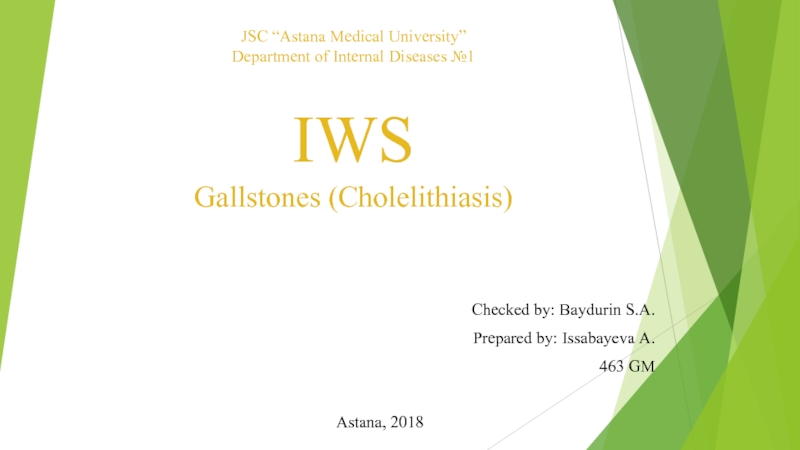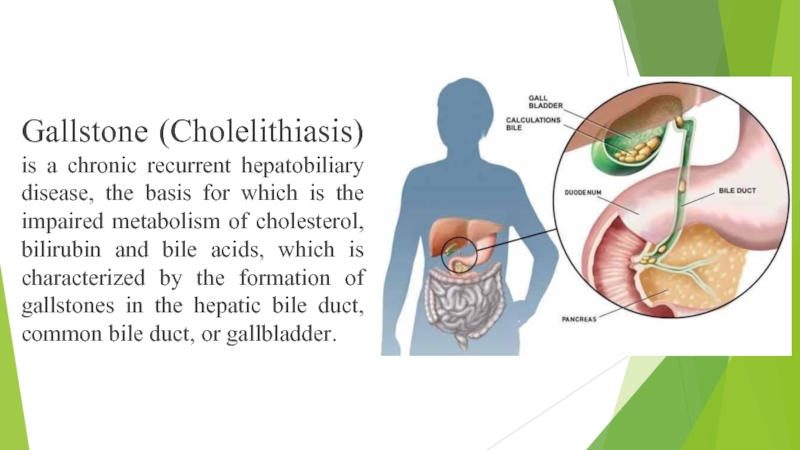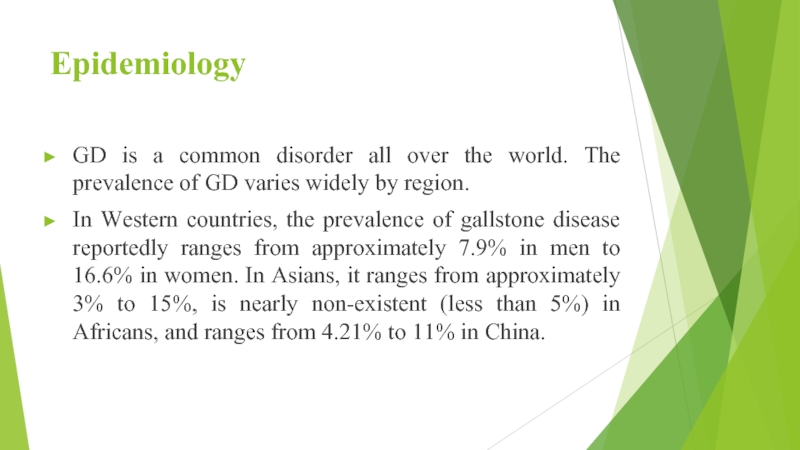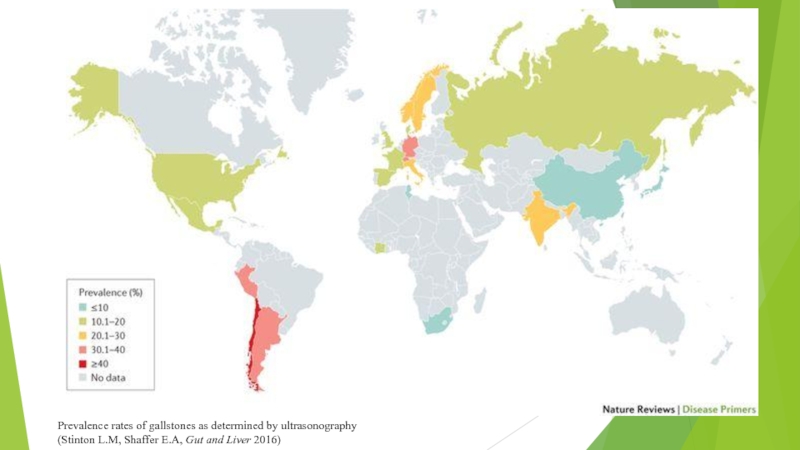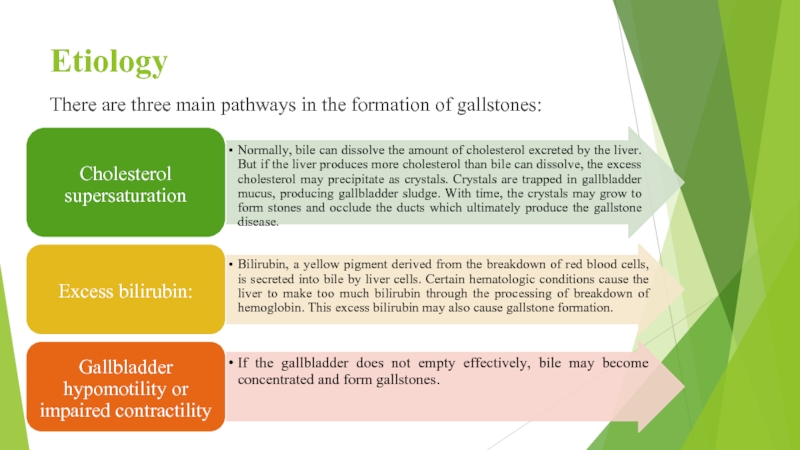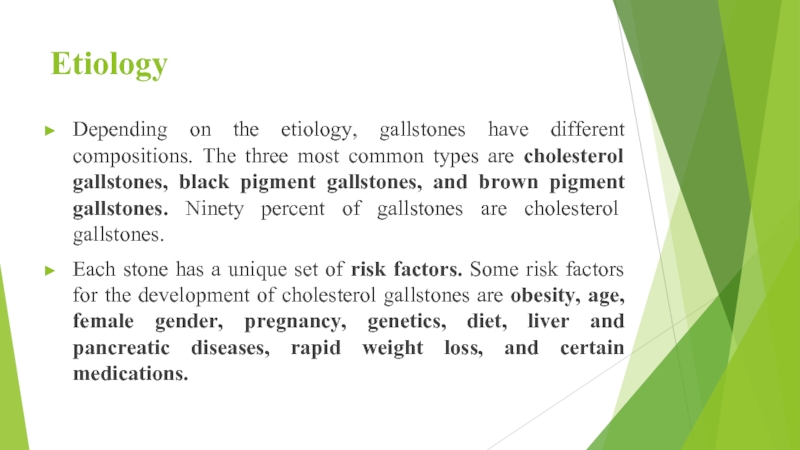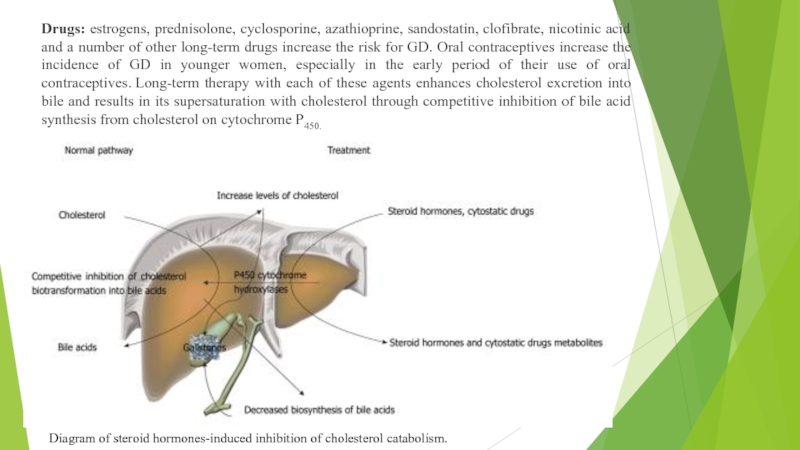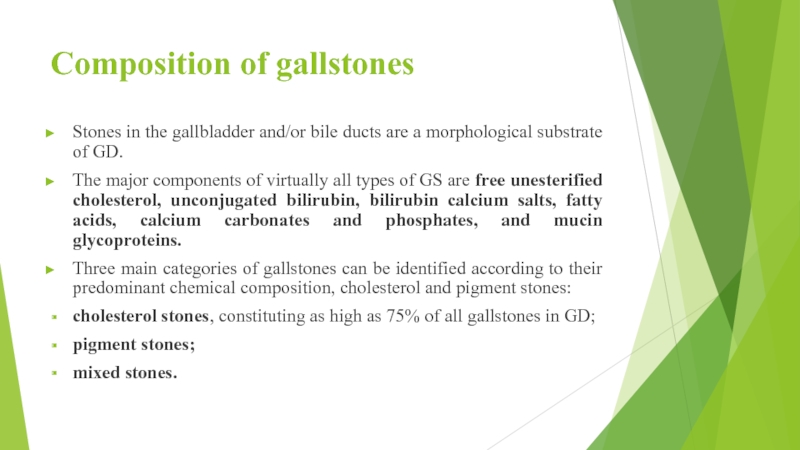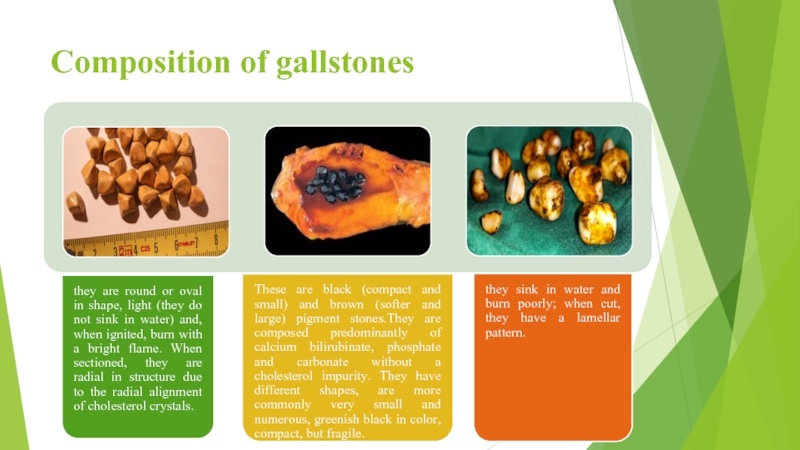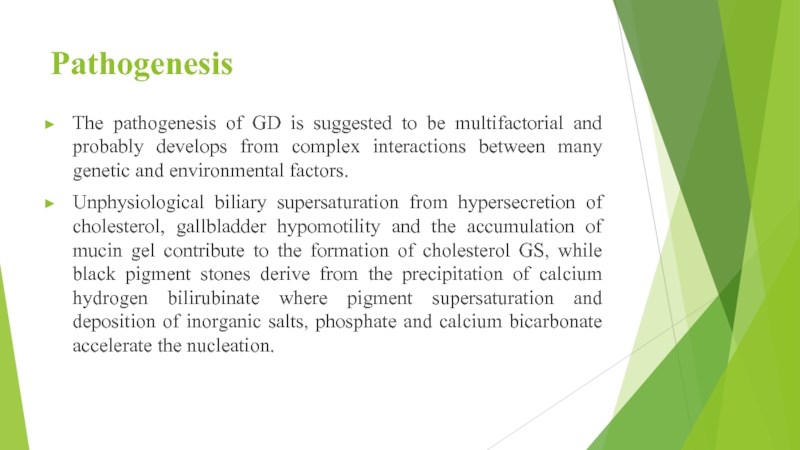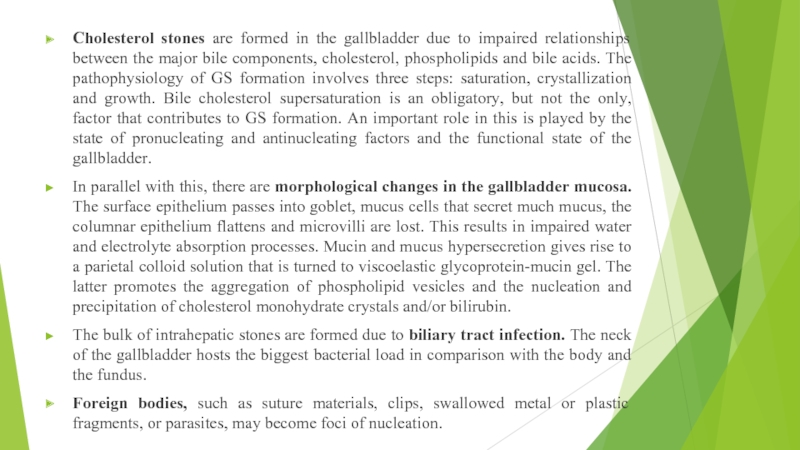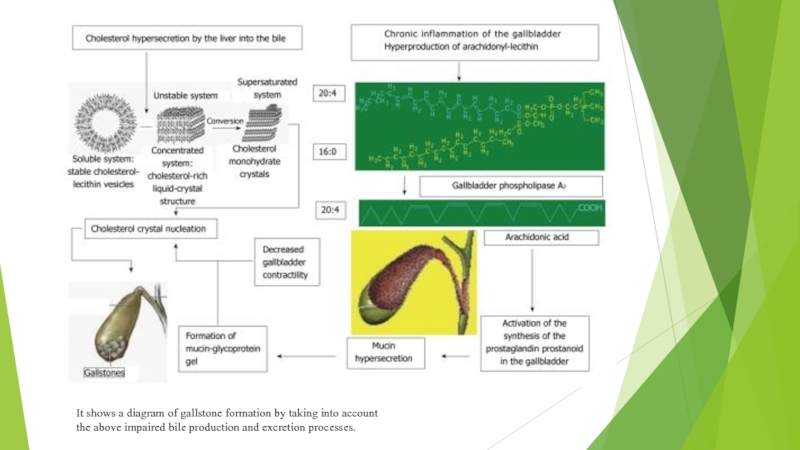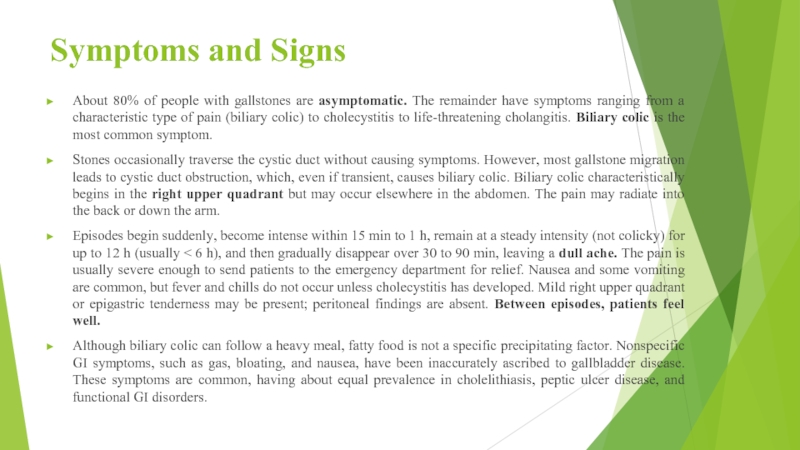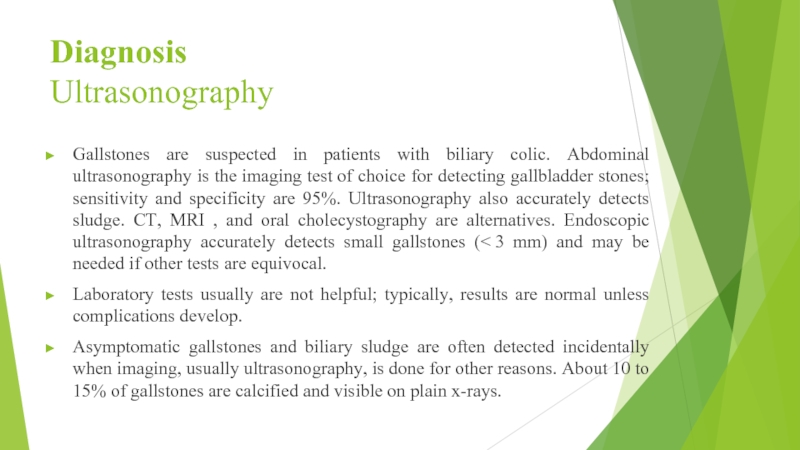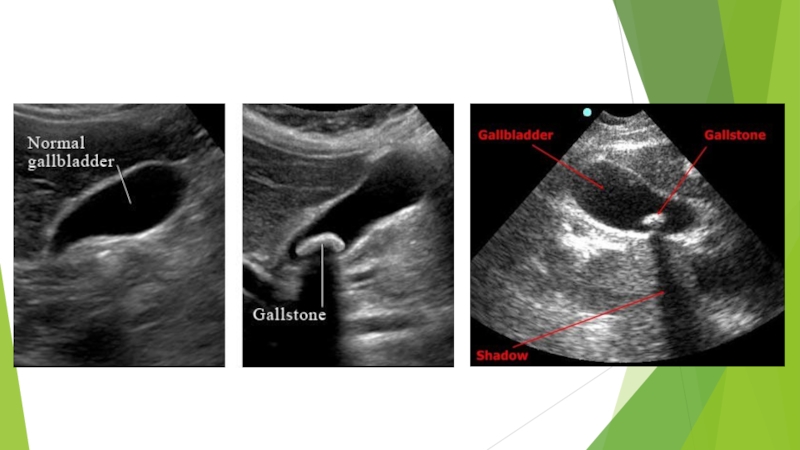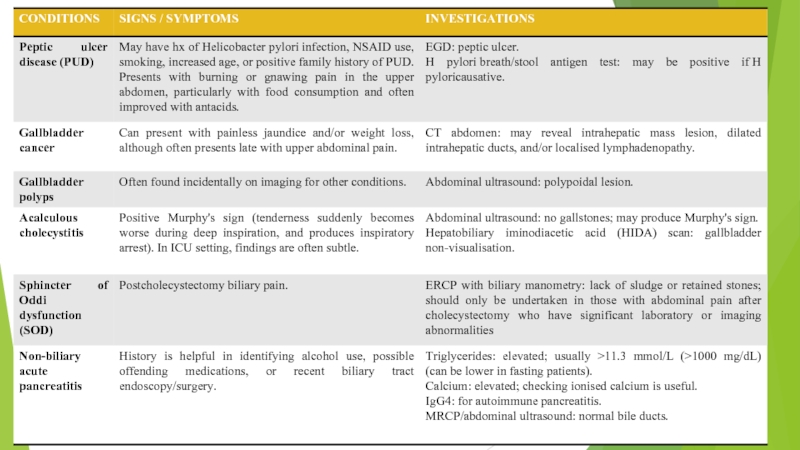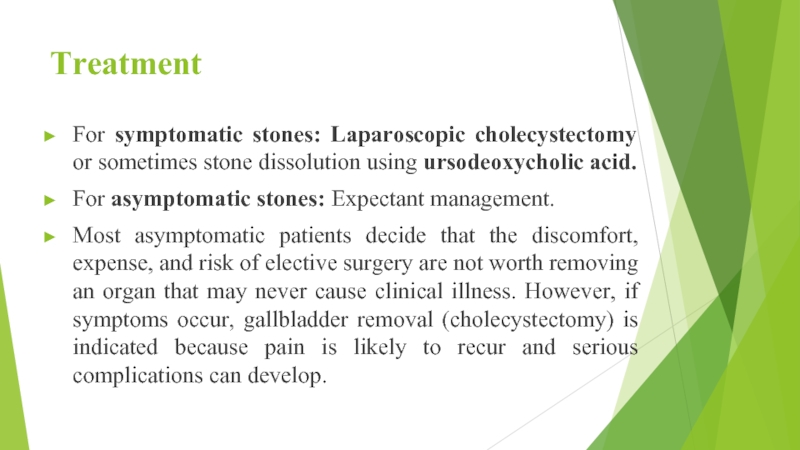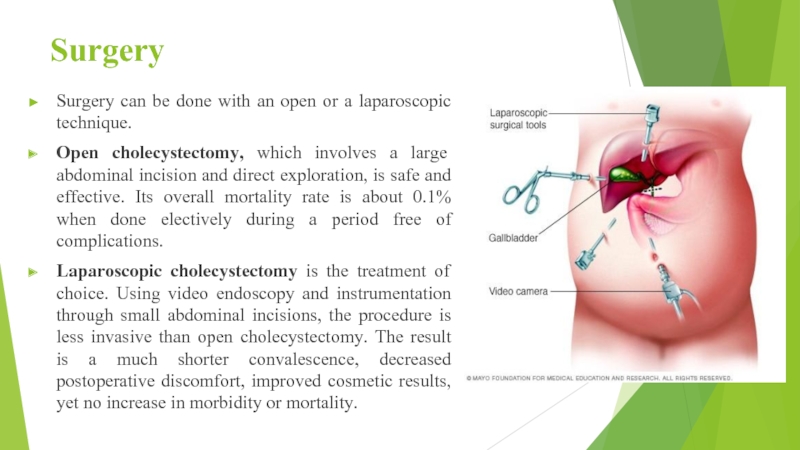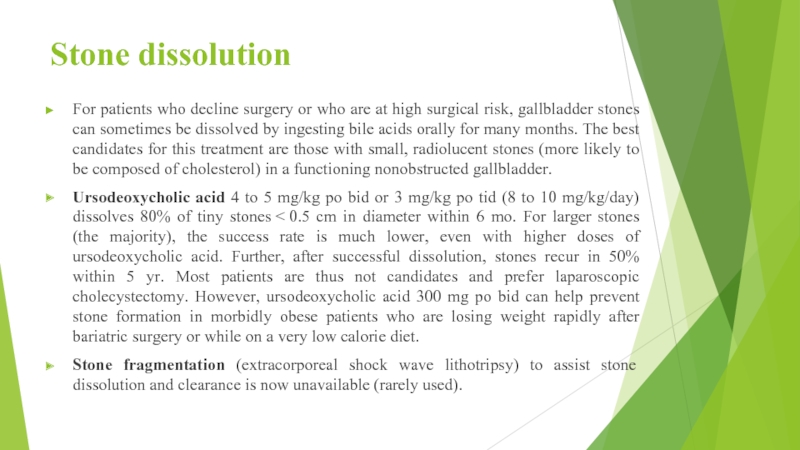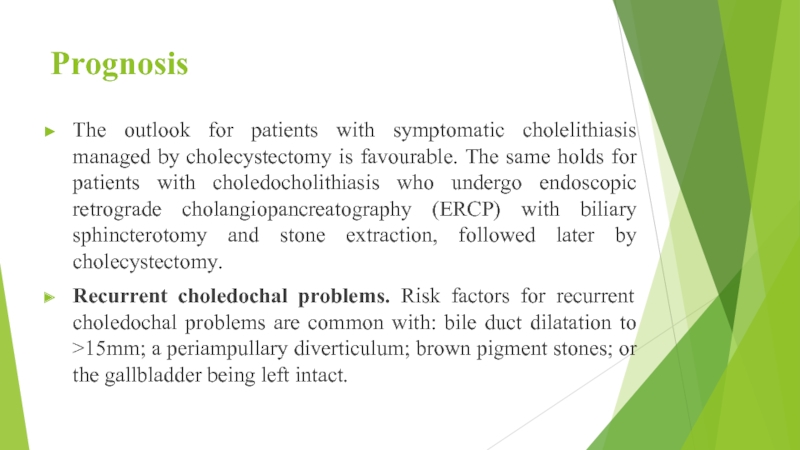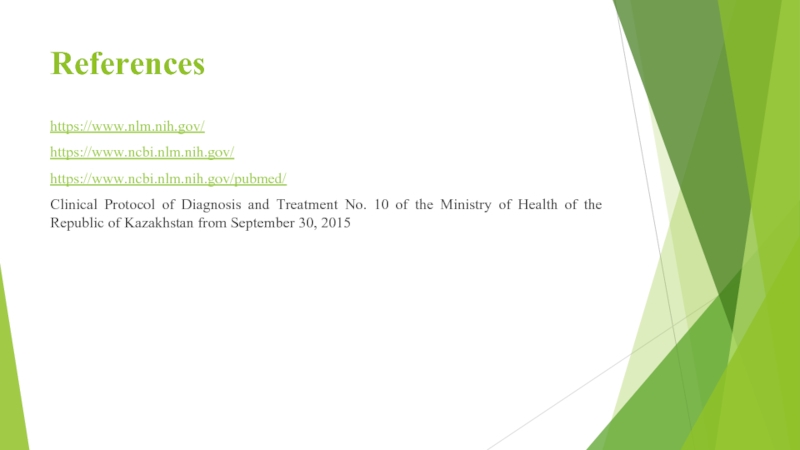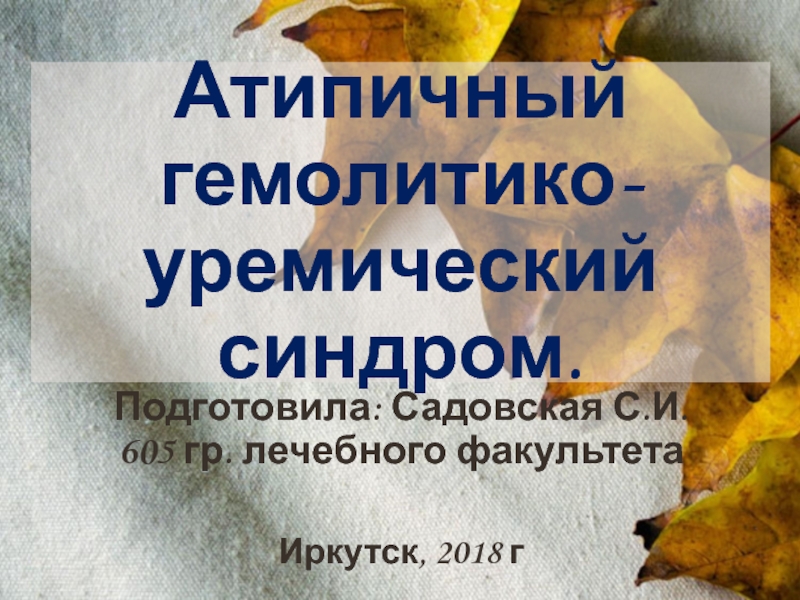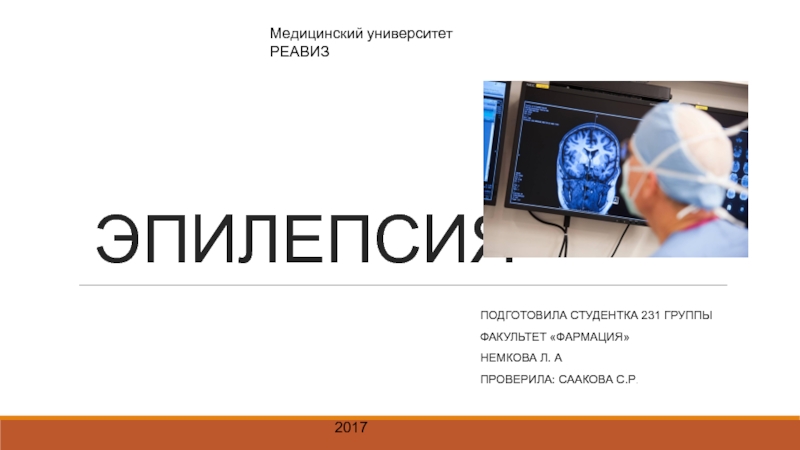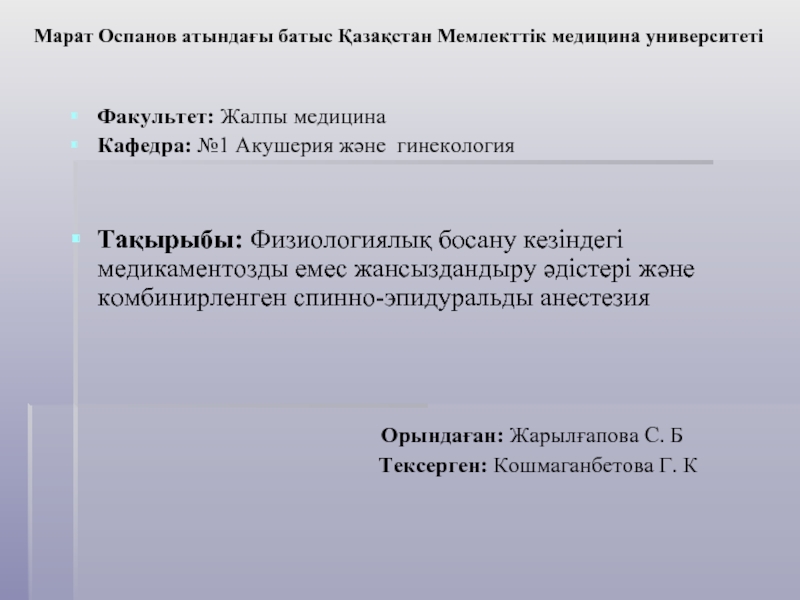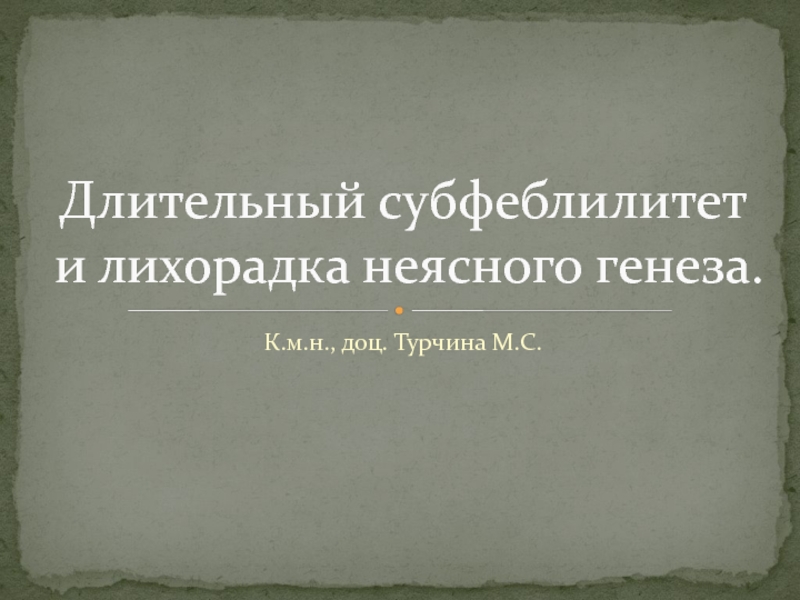S.A.
Prepared by: Issabayeva A.
463 GM
Astana, 2018
- Главная
- Разное
- Дизайн
- Бизнес и предпринимательство
- Аналитика
- Образование
- Развлечения
- Красота и здоровье
- Финансы
- Государство
- Путешествия
- Спорт
- Недвижимость
- Армия
- Графика
- Культурология
- Еда и кулинария
- Лингвистика
- Английский язык
- Астрономия
- Алгебра
- Биология
- География
- Детские презентации
- Информатика
- История
- Литература
- Маркетинг
- Математика
- Медицина
- Менеджмент
- Музыка
- МХК
- Немецкий язык
- ОБЖ
- Обществознание
- Окружающий мир
- Педагогика
- Русский язык
- Технология
- Физика
- Философия
- Химия
- Шаблоны, картинки для презентаций
- Экология
- Экономика
- Юриспруденция
Gallstones (Cholelithiasis) презентация
Содержание
- 1. Gallstones (Cholelithiasis)
- 2. Gallstone (Cholelithiasis) is a chronic recurrent hepatobiliary
- 3. Epidemiology GD is a common disorder all
- 4. Prevalence rates of gallstones as determined by ultrasonography (Stinton L.M, Shaffer E.A, Gut and Liver 2016)
- 5. Etiology There are three main pathways in the formation of gallstones:
- 6. Etiology Depending on the etiology, gallstones have
- 7. Diagram of steroid hormones-induced inhibition of cholesterol
- 8. Composition of gallstones Stones in the gallbladder
- 9. Composition of gallstones
- 10. Pathogenesis The pathogenesis of GD is suggested
- 11. Cholesterol stones are formed in the gallbladder
- 12. It shows a diagram of gallstone formation
- 13. Symptoms and Signs About 80% of people
- 14. Diagnosis Ultrasonography Gallstones are suspected in patients
- 17. Treatment For symptomatic stones: Laparoscopic cholecystectomy or
- 18. Surgery Surgery can be done with an
- 19. Stone dissolution For patients who decline surgery
- 20. Prognosis The outlook for patients with symptomatic
- 21. References https://www.nlm.nih.gov/ https://www.ncbi.nlm.nih.gov/ https://www.ncbi.nlm.nih.gov/pubmed/ Clinical Protocol
Слайд 1JSC “Astana Medical University”
Department of Internal Diseases №1
IWS
Gallstones (Cholelithiasis)
Checked by: Baydurin
Слайд 2Gallstone (Cholelithiasis) is a chronic recurrent hepatobiliary disease, the basis for
which is the impaired metabolism of cholesterol, bilirubin and bile acids, which is characterized by the formation of gallstones in the hepatic bile duct, common bile duct, or gallbladder.
Слайд 3Epidemiology
GD is a common disorder all over the world. The prevalence
of GD varies widely by region.
In Western countries, the prevalence of gallstone disease reportedly ranges from approximately 7.9% in men to 16.6% in women. In Asians, it ranges from approximately 3% to 15%, is nearly non-existent (less than 5%) in Africans, and ranges from 4.21% to 11% in China.
In Western countries, the prevalence of gallstone disease reportedly ranges from approximately 7.9% in men to 16.6% in women. In Asians, it ranges from approximately 3% to 15%, is nearly non-existent (less than 5%) in Africans, and ranges from 4.21% to 11% in China.
Слайд 4Prevalence rates of gallstones as determined by ultrasonography
(Stinton L.M, Shaffer E.A, Gut
and Liver 2016)
Слайд 6Etiology
Depending on the etiology, gallstones have different compositions. The three most
common types are cholesterol gallstones, black pigment gallstones, and brown pigment gallstones. Ninety percent of gallstones are cholesterol gallstones.
Each stone has a unique set of risk factors. Some risk factors for the development of cholesterol gallstones are obesity, age, female gender, pregnancy, genetics, diet, liver and pancreatic diseases, rapid weight loss, and certain medications.
Each stone has a unique set of risk factors. Some risk factors for the development of cholesterol gallstones are obesity, age, female gender, pregnancy, genetics, diet, liver and pancreatic diseases, rapid weight loss, and certain medications.
Слайд 7Diagram of steroid hormones-induced inhibition of cholesterol catabolism.
Drugs: estrogens, prednisolone, cyclosporine,
azathioprine, sandostatin, clofibrate, nicotinic acid and a number of other long-term drugs increase the risk for GD. Oral contraceptives increase the incidence of GD in younger women, especially in the early period of their use of oral contraceptives. Long-term therapy with each of these agents enhances cholesterol excretion into bile and results in its supersaturation with cholesterol through competitive inhibition of bile acid synthesis from cholesterol on cytochrome Р450.
Слайд 8Composition of gallstones
Stones in the gallbladder and/or bile ducts are a
morphological substrate of GD.
The major components of virtually all types of GS are free unesterified cholesterol, unconjugated bilirubin, bilirubin calcium salts, fatty acids, calcium carbonates and phosphates, and mucin glycoproteins.
Three main categories of gallstones can be identified according to their predominant chemical composition, cholesterol and pigment stones:
cholesterol stones, constituting as high as 75% of all gallstones in GD;
pigment stones;
mixed stones.
The major components of virtually all types of GS are free unesterified cholesterol, unconjugated bilirubin, bilirubin calcium salts, fatty acids, calcium carbonates and phosphates, and mucin glycoproteins.
Three main categories of gallstones can be identified according to their predominant chemical composition, cholesterol and pigment stones:
cholesterol stones, constituting as high as 75% of all gallstones in GD;
pigment stones;
mixed stones.
Слайд 10Pathogenesis
The pathogenesis of GD is suggested to be multifactorial and probably
develops from complex interactions between many genetic and environmental factors.
Unphysiological biliary supersaturation from hypersecretion of cholesterol, gallbladder hypomotility and the accumulation of mucin gel contribute to the formation of cholesterol GS, while black pigment stones derive from the precipitation of calcium hydrogen bilirubinate where pigment supersaturation and deposition of inorganic salts, phosphate and calcium bicarbonate accelerate the nucleation.
Unphysiological biliary supersaturation from hypersecretion of cholesterol, gallbladder hypomotility and the accumulation of mucin gel contribute to the formation of cholesterol GS, while black pigment stones derive from the precipitation of calcium hydrogen bilirubinate where pigment supersaturation and deposition of inorganic salts, phosphate and calcium bicarbonate accelerate the nucleation.
Слайд 11Cholesterol stones are formed in the gallbladder due to impaired relationships
between the major bile components, cholesterol, phospholipids and bile acids. The pathophysiology of GS formation involves three steps: saturation, crystallization and growth. Bile cholesterol supersaturation is an obligatory, but not the only, factor that contributes to GS formation. An important role in this is played by the state of pronucleating and antinucleating factors and the functional state of the gallbladder.
In parallel with this, there are morphological changes in the gallbladder mucosa. The surface epithelium passes into goblet, mucus cells that secret much mucus, the columnar epithelium flattens and microvilli are lost. This results in impaired water and electrolyte absorption processes. Mucin and mucus hypersecretion gives rise to a parietal colloid solution that is turned to viscoelastic glycoprotein-mucin gel. The latter promotes the aggregation of phospholipid vesicles and the nucleation and precipitation of cholesterol monohydrate crystals and/or bilirubin.
The bulk of intrahepatic stones are formed due to biliary tract infection. The neck of the gallbladder hosts the biggest bacterial load in comparison with the body and the fundus.
Foreign bodies, such as suture materials, clips, swallowed metal or plastic fragments, or parasites, may become foci of nucleation.
In parallel with this, there are morphological changes in the gallbladder mucosa. The surface epithelium passes into goblet, mucus cells that secret much mucus, the columnar epithelium flattens and microvilli are lost. This results in impaired water and electrolyte absorption processes. Mucin and mucus hypersecretion gives rise to a parietal colloid solution that is turned to viscoelastic glycoprotein-mucin gel. The latter promotes the aggregation of phospholipid vesicles and the nucleation and precipitation of cholesterol monohydrate crystals and/or bilirubin.
The bulk of intrahepatic stones are formed due to biliary tract infection. The neck of the gallbladder hosts the biggest bacterial load in comparison with the body and the fundus.
Foreign bodies, such as suture materials, clips, swallowed metal or plastic fragments, or parasites, may become foci of nucleation.
Слайд 12It shows a diagram of gallstone formation by taking into account
the
above impaired bile production and excretion processes.
Слайд 13Symptoms and Signs
About 80% of people with gallstones are asymptomatic. The
remainder have symptoms ranging from a characteristic type of pain (biliary colic) to cholecystitis to life-threatening cholangitis. Biliary colic is the most common symptom.
Stones occasionally traverse the cystic duct without causing symptoms. However, most gallstone migration leads to cystic duct obstruction, which, even if transient, causes biliary colic. Biliary colic characteristically begins in the right upper quadrant but may occur elsewhere in the abdomen. The pain may radiate into the back or down the arm.
Episodes begin suddenly, become intense within 15 min to 1 h, remain at a steady intensity (not colicky) for up to 12 h (usually < 6 h), and then gradually disappear over 30 to 90 min, leaving a dull ache. The pain is usually severe enough to send patients to the emergency department for relief. Nausea and some vomiting are common, but fever and chills do not occur unless cholecystitis has developed. Mild right upper quadrant or epigastric tenderness may be present; peritoneal findings are absent. Between episodes, patients feel well.
Although biliary colic can follow a heavy meal, fatty food is not a specific precipitating factor. Nonspecific GI symptoms, such as gas, bloating, and nausea, have been inaccurately ascribed to gallbladder disease. These symptoms are common, having about equal prevalence in cholelithiasis, peptic ulcer disease, and functional GI disorders.
Stones occasionally traverse the cystic duct without causing symptoms. However, most gallstone migration leads to cystic duct obstruction, which, even if transient, causes biliary colic. Biliary colic characteristically begins in the right upper quadrant but may occur elsewhere in the abdomen. The pain may radiate into the back or down the arm.
Episodes begin suddenly, become intense within 15 min to 1 h, remain at a steady intensity (not colicky) for up to 12 h (usually < 6 h), and then gradually disappear over 30 to 90 min, leaving a dull ache. The pain is usually severe enough to send patients to the emergency department for relief. Nausea and some vomiting are common, but fever and chills do not occur unless cholecystitis has developed. Mild right upper quadrant or epigastric tenderness may be present; peritoneal findings are absent. Between episodes, patients feel well.
Although biliary colic can follow a heavy meal, fatty food is not a specific precipitating factor. Nonspecific GI symptoms, such as gas, bloating, and nausea, have been inaccurately ascribed to gallbladder disease. These symptoms are common, having about equal prevalence in cholelithiasis, peptic ulcer disease, and functional GI disorders.
Слайд 14Diagnosis
Ultrasonography
Gallstones are suspected in patients with biliary colic. Abdominal ultrasonography is
the imaging test of choice for detecting gallbladder stones; sensitivity and specificity are 95%. Ultrasonography also accurately detects sludge. CT, MRI , and oral cholecystography are alternatives. Endoscopic ultrasonography accurately detects small gallstones (< 3 mm) and may be needed if other tests are equivocal.
Laboratory tests usually are not helpful; typically, results are normal unless complications develop.
Asymptomatic gallstones and biliary sludge are often detected incidentally when imaging, usually ultrasonography, is done for other reasons. About 10 to 15% of gallstones are calcified and visible on plain x-rays.
Laboratory tests usually are not helpful; typically, results are normal unless complications develop.
Asymptomatic gallstones and biliary sludge are often detected incidentally when imaging, usually ultrasonography, is done for other reasons. About 10 to 15% of gallstones are calcified and visible on plain x-rays.
Слайд 17Treatment
For symptomatic stones: Laparoscopic cholecystectomy or sometimes stone dissolution using ursodeoxycholic
acid.
For asymptomatic stones: Expectant management.
Most asymptomatic patients decide that the discomfort, expense, and risk of elective surgery are not worth removing an organ that may never cause clinical illness. However, if symptoms occur, gallbladder removal (cholecystectomy) is indicated because pain is likely to recur and serious complications can develop.
For asymptomatic stones: Expectant management.
Most asymptomatic patients decide that the discomfort, expense, and risk of elective surgery are not worth removing an organ that may never cause clinical illness. However, if symptoms occur, gallbladder removal (cholecystectomy) is indicated because pain is likely to recur and serious complications can develop.
Слайд 18Surgery
Surgery can be done with an open or a laparoscopic technique.
Open
cholecystectomy, which involves a large abdominal incision and direct exploration, is safe and effective. Its overall mortality rate is about 0.1% when done electively during a period free of complications.
Laparoscopic cholecystectomy is the treatment of choice. Using video endoscopy and instrumentation through small abdominal incisions, the procedure is less invasive than open cholecystectomy. The result is a much shorter convalescence, decreased postoperative discomfort, improved cosmetic results, yet no increase in morbidity or mortality.
Laparoscopic cholecystectomy is the treatment of choice. Using video endoscopy and instrumentation through small abdominal incisions, the procedure is less invasive than open cholecystectomy. The result is a much shorter convalescence, decreased postoperative discomfort, improved cosmetic results, yet no increase in morbidity or mortality.
Слайд 19Stone dissolution
For patients who decline surgery or who are at high
surgical risk, gallbladder stones can sometimes be dissolved by ingesting bile acids orally for many months. The best candidates for this treatment are those with small, radiolucent stones (more likely to be composed of cholesterol) in a functioning nonobstructed gallbladder.
Ursodeoxycholic acid 4 to 5 mg/kg po bid or 3 mg/kg po tid (8 to 10 mg/kg/day) dissolves 80% of tiny stones < 0.5 cm in diameter within 6 mo. For larger stones (the majority), the success rate is much lower, even with higher doses of ursodeoxycholic acid. Further, after successful dissolution, stones recur in 50% within 5 yr. Most patients are thus not candidates and prefer laparoscopic cholecystectomy. However, ursodeoxycholic acid 300 mg po bid can help prevent stone formation in morbidly obese patients who are losing weight rapidly after bariatric surgery or while on a very low calorie diet.
Stone fragmentation (extracorporeal shock wave lithotripsy) to assist stone dissolution and clearance is now unavailable (rarely used).
Ursodeoxycholic acid 4 to 5 mg/kg po bid or 3 mg/kg po tid (8 to 10 mg/kg/day) dissolves 80% of tiny stones < 0.5 cm in diameter within 6 mo. For larger stones (the majority), the success rate is much lower, even with higher doses of ursodeoxycholic acid. Further, after successful dissolution, stones recur in 50% within 5 yr. Most patients are thus not candidates and prefer laparoscopic cholecystectomy. However, ursodeoxycholic acid 300 mg po bid can help prevent stone formation in morbidly obese patients who are losing weight rapidly after bariatric surgery or while on a very low calorie diet.
Stone fragmentation (extracorporeal shock wave lithotripsy) to assist stone dissolution and clearance is now unavailable (rarely used).
Слайд 20Prognosis
The outlook for patients with symptomatic cholelithiasis managed by cholecystectomy is
favourable. The same holds for patients with choledocholithiasis who undergo endoscopic retrograde cholangiopancreatography (ERCP) with biliary sphincterotomy and stone extraction, followed later by cholecystectomy.
Recurrent choledochal problems. Risk factors for recurrent choledochal problems are common with: bile duct dilatation to >15mm; a periampullary diverticulum; brown pigment stones; or the gallbladder being left intact.
Recurrent choledochal problems. Risk factors for recurrent choledochal problems are common with: bile duct dilatation to >15mm; a periampullary diverticulum; brown pigment stones; or the gallbladder being left intact.
Слайд 21References
https://www.nlm.nih.gov/
https://www.ncbi.nlm.nih.gov/
https://www.ncbi.nlm.nih.gov/pubmed/
Clinical Protocol of Diagnosis and Treatment No. 10 of the
Ministry of Health of the Republic of Kazakhstan from September 30, 2015
